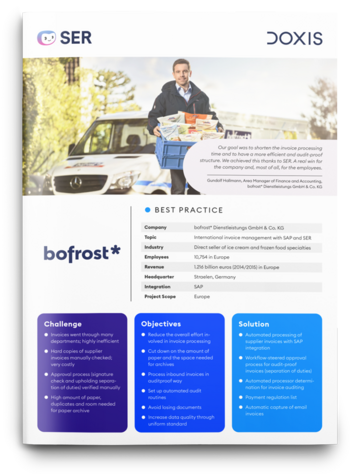SER Blog Customer Stories & Use Cases
Streamlining B2B invoicing and data exchange with Peppol
Peppol is an international network for exchanging electronic documents online. Developed to create standardized and simplified procurement processes and tendering activities between companies and public authorities across Europe, Peppol is now also becoming more important in the B2B sector and is especially central in helping businesses meet mandatory eInvoicing requirements. And as B2B eInvoicing gains momentum, Peppol’s standardized approach offers international businesses a fully digital, seamless invoicing process, eliminating manual re-entry and format conversion issues.
Keep reading to learn all about how Peppol works, who uses it and what the network means for the coming requirements of mandatory eInvoicing.

What is Peppol?
Peppol stands for Pan-European Public Procurement Online. This is an international network operated by the non-profit organization OpenPeppol. Organizations use the network to exchange documents with each other worldwide as part of electronic procurement processes.
Peppol was originally developed from a desire to make public sector tenders more accessible for SMEs across borders in the European Union, but over time, it’s become critical for companies who need standardized document transfer on an international level.
Objectives and benefits of Peppol
The broad objective of Peppol is to provide a technical infrastructure that standardizes and harmonizes the exchange of documents in international e-procurement processes between companies and authorities. This has some major benefits for businesses like your own:
- Peppol transmits all documents as part of procurement processes and digitally manages all electronic correspondence online.
- Peppol standardizes the transmission channel for documents so that it complies with applicable regulations and standards in different countries.
- Peppol enables automated electronic transmission of documents from machine to machine (M2M), which in turn reduces operator errors.
- Peppol makes document exchange between organizations more efficient, for example, by supporting bulk exports of electronic invoices.
Network and a format? Let’s clear things up
Peppol serves a dual role when it comes to electronic document exchange:
- Peppol as a network: Peppol operates as an international framework facilitating the secure and standardized exchange of electronic procurement documents across borders. Organizations connect to this network through certified Access Points, enabling seamless communication regardless of differing internal systems.
- Peppol as a format: Beyond its networking capabilities, Peppol provides standardized document specifications, known as Peppol BIS (Business Interoperability Specifications). These specifications define the structure and content of documents like invoices and orders, ensuring consistency and compliance with various regional regulations. Also, it’s fully compliant with the EN 16931.

Doxis Intelligent Invoice Automation
Learn how to automate inbound invoice workflows, expedite invoice processing and save costs — with Doxis Intelligent Invoice Automation.
Read nowHow does Peppol work?
A good way to think of Peppol is as a network. This means that you can use Peppol to send procurement documents electronically, including invoices, supplier confirmations or catalogs between senders and recipients.
In this network, both sender and recipient must connect through a certified Peppol Access Point, which each country has, and acts as the gateway for exchanging documents securely and reliably.
Peppol’s standardized format and access points facilitate easy communication across different countries and systems, making it particularly valuable for B2B transactions in multinational operations.
Technical principles and standards
Organizations exchange data through Peppol’s eDelivery network, accessing it via Peppol access points, primarily operated by private sector organizations. Each access point assigns a Peppol ID to a company, which is then used to register in the eDelivery network. Data exchange within this network follows a 4-corner model, which includes the following components:
- the sender,
- the Peppol access point of the sender,
- the recipient and
- the recipient's Peppol access point.
The Peppol process: from sender to recipient
In the 4-corner model, the process of sending an eInvoice between the invoice sender and invoice recipient might look like the following example:
- The sender sends the eInvoice to their own access point, and provides the recipient's Peppol ID.
- The eInvoice is then sent from the sender's access point to the recipient’s access point, based on the recipient’s Peppol ID.
- The recipient's invoice receipt platform receives the eInvoice for inbound invoice processing.
Security and compliance on the Peppol network
Peppol ensures secure data transmission in both B2B and B2G environments, meeting the highest standards for data protection at every step, including when sending documents to access points. Authorized access points are easily identified by their Peppol certification.
The Peppol network also complies with all data protection regulations. Buyers and businesses communicate securely and transparently, taking into account all legally required standards and regulations, since cause Peppol records every interaction.
Who can use Peppol?
Peppol is an international network that enables standardized electronic document exchanges, such as invoices and orders, between businesses and government entities. It is widely adopted across Europe and in countries like Singapore, Australia and New Zealand.
While Peppol offers a unified framework for eInvoicing, it is not universally mandated or the sole solution in all countries. Some nations have their own eInvoicing platforms and regulations that may not be fully interoperable with Peppol. For instance, in Germany, the XRechnung standard is used for invoicing federal government entities, and while Peppol can facilitate these transactions, it is not the only method available.
It’s best that businesses assess the specific eInvoicing requirements of each country they operate in. In some cases, integrating with local platforms may be necessary alongside or instead of using Peppol to ensure compliance with national regulations.
While Peppol was originally adopted by public administrations to meet EU-mandated eInvoicing standards (such as the 2014/55/EU Directive), it has since expanded its reach. Today, it’s the private sector that’s pushing Peppol to new heights, making it an essential tool for efficient, reliable transactions across diverse regions and regulatory environments.
And while it’s great for streamlining B2B invoicing internationally, it doesn’t always replace country-specific platforms like France’s Chorus Pro, for instance, which is required for invoicing government entities and can be used for B2B as well. Peppol’s real strength is making trading between partners more efficient through secure, standardized document exchange. This approach often means companies end up meeting compliance and interoperability needs naturally, but Peppol usually works alongside local systems rather than acting as a complete compliance solution on its own.

bofrost*: Automated inbound invoice processing with ECM & SAP
Read all about how bofrost* automates its invoice processing with Doxis, saving time and money along the way
Read nowLegal and regulatory aspects
The BIS Billing format utilized in Peppol complies with the European standard EN 16931, making it sufficient for meeting various mandatory eInvoicing regulations across Europe. This means that if you're trading within the network that accepts Peppol, the BIS Billing format is standardized enough to fulfill the requirements, without needing to convert into country-specific formats like Germany’s XRechnung or France’s Factur-X. This standardization simplifies processes by ensuring that a single format is compatible across multiple jurisdictions, reducing the complexity of having to manage different eInvoicing formats for each country.
Why does this matter?
For any business dealing internationally, especially with partners in Europe, it’s crucial to use the right eInvoice format to ensure transactions go smoothly and meet local regulations. Peppol’s network makes this easier by supporting a range of formats, like UBL (Universal Business Language) and Cross Industry Invoice (CII), so companies don’t have to worry about reformatting invoices for each country.
When you connect through Peppol, your businesses will be able to handle invoicing requirements for the various countries on its network, knowing your eInvoices will meet local standards without extra hassle. This makes cross-border transactions simpler and keeps everything running smoothly.
Processing inbound Peppol invoices with Doxis
You can manage inbound Peppol invoices seamlessly using Doxis eDocument Exchange for Incoming Invoices. This setup enables immediate handling of eInvoices, eliminating any delay.
6 steps of invoice processing in Doxis
- Accept inbound invoices: Doxis automatically accepts the digital inbound invoice for processing via the Peppol interface.
- Capture invoice details: Doxis records all relevant invoice details and prepares it for interpretation. Doxis then stores the eInvoice in a context-related digital file.
- Review invoices: Doxis checks whether the inbound invoice is factually and formally correct. If everything is correct, Doxis transfers the invoice data to your ERP system in the proper format.
- Approve invoices: Doxis triggers the approval workflow for verified eInvoices for you by forwarding the eInvoice to the responsible employee. They then release the invoice rapidly as part of the internal, multi-stage approval process. In the context of AP automation, for example, for invoices below a defined threshold, no human in the loop is required.
- Post invoice: Doxis transmits the posting-relevant data of approved eInvoices to your ERP or financial accounting system. Employees then process the posting by the due date.
- Audit-proof invoice archiving: Doxis archives the eInvoice in an audit-proof manner in accordance with GoBD standards.
Connect Peppol with inbound invoice platforms and automate processes
To wrap up, let’s quickly review what we’ve learnt. So, we know that companies and organizations use Peppol to exchange documents during procurement processes, which makes local and cross-border transactions smoother and more efficient. And with the standardization of data exchange, sending documents like eInvoices becomes effortless.
We’ve also found that eInvoices can be submitted via Peppol using the BIS Billing format, which is designed to meet European eInvoicing standards and aligns well with various national formats, such as the previously mentioned XRechnung in Germany and Factur-X in France. To ensure a seamless process without interruptions, we also recommended implementing a modern, AI-powered DMS like Doxis to collect incoming eInvoices directly through the Peppol interface. This setup allows you to automate your incoming invoice processing from start to finish.
Ready to see the full benefits of a modern DMS? Get in touch! Our experts will be happy to walk you through our platform’s powerful eInvoicing capabilities.
FAQs about Peppol
The latest digitization trends, laws and guidelines, and helpful tips straight to your inbox: Subscribe to our newsletter.
How can we help you?
+49 (0) 30 498582-0Your message has reached us!
We appreciate your interest and will get back to you shortly.




